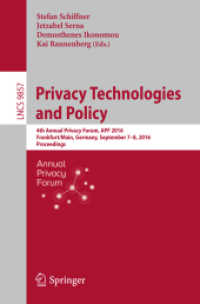- ホーム
- > 洋書
- > 英文書
- > Religion / Ethics
Full Description
The Cambridge Introduction to Biblical Hebrew is designed for anyone studying biblical Hebrew for the first time. It is well suited for students enrolled in introductory-level courses as well as clergy and laity engaged in self-study. The accompanying CD (suitable for Mac and PC) includes the workbook, answers, paradigms, and the interactive program TekScroll. TekScroll greatly facilitates learning through grammar illustrations with moving graphics, interactive parsing programs, translation practice items, and a vocabulary program. The grammar illustrations demonstrate key grammatical points. The parsing programs provide feedback, hints, and corrections. Translation practice comes primarily from biblical verses. The vocabulary quizzing program includes audio of the vocabulary words. The textbook is designed for a two-semester course covering one chapter of grammar per week (22 chapters) and then turning to select syntactical items. Each chapter begins with a Focus section, identifying key elements, and is followed by a summary, vocabulary list, and description of the learning activities on the CD. The practice translation items and workbook exercises use only vocabulary from previous chapters (with few exceptions), so that they can be used immediately in classroom instruction.
Contents
Introduction; 1. The signs and sounds of Hebrewpronunciation; 2. Syllables: the structural girders of Hebrew; 3. The 'state' of noun morphology, and also gender and number; 4. More noun patterns; 5. Prepositions, conjunction, article and interrogative particle, direct object indicator; 6. Pronouns: pronominal suffixes on substantives and prepositions; 7. Adjectives; 8. Participles: infinitive construct; 9. Selected words: numbers; 10. Introduction to verbs: qal perfect; 11. Qal perfect weak verbs; 12. Qal imperfect and preterite: strong verbs; 13. Qal imperfect and preterite: weak verbs; 14. Qal volitionals and infinitive absolute; 15. Pronominal suffixes on verbs; 16. Derived stems: participles and infinitives; 17. I-class imperfect verbs: niphal, piel, hitpael, hiphil; 18. I-class imperfects: r3 = weak, r2 = g, r1 = g, r2 = x, r1 = x; 19. I-class imperfect weak verbs: r2 = y, r1 = y, r2 = r3, weak imv., inf., and ptc.; 20. A-class imperfect verbs: pual, hophal; 21. Derived stem perfects: strong verbs, r3 = weak; 22. Derived stem perfects: r1 and r2 weak, r2 = r3, rare binyanim; Excursus A: Sorting through forms and alias profiles; Excursus B: A syntax sampler: introduction to chapters 23-32; 23. Pauses and drama; 24. Lexicography: semantic combinations and the meaning of z; 25. Noun syntax; 26. Verb syntax: the piel; 27. Verb syntax: participles; 28. Clausal syntax in narrative: movies in the mind; 29. Particles: s and t; 30. Infinitives; 31. Perfect and vav plus perfect; 32. Poetry and time frame; Appendix A: Additional vocabulary lists; Appendix B: Glossary: words used 50+ times in the Hebrew Bible; Appendix C: Paradigms: verb id badges and alias profiles.






